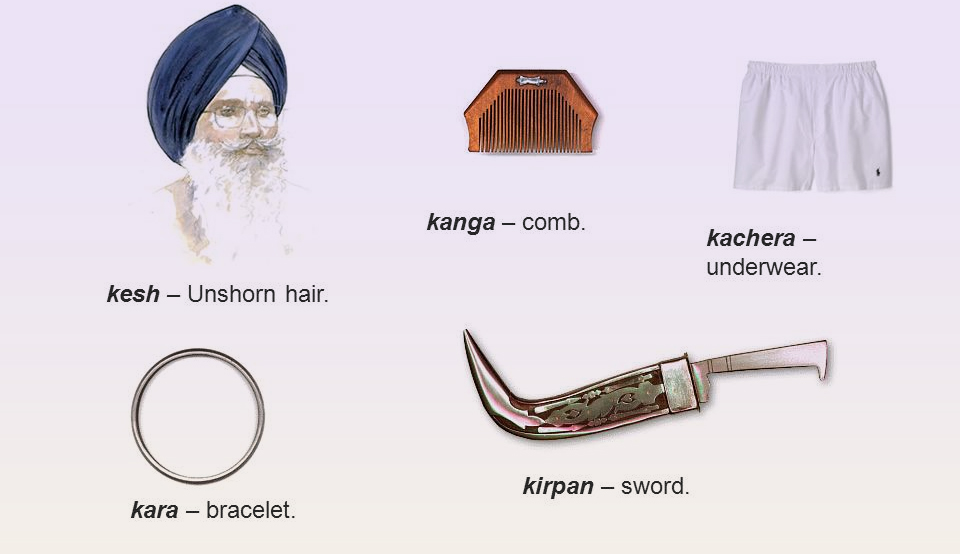
History of the 5 Kakaars of Sikhs
The 5 Kakaars, also known as the Five Ks, are five articles of faith that are mandatory for all initiated Sikhs. These were established by Guru Gobind Singh, the tenth Guru of the Sikhs, in 1699 when he created the Khalsa, a community of committed Sikhs. The Five Ks are meant to embody the principles of Sikhism and the identity of a Khalsa.
1. – Kesh (Uncut Hair) : – Kesh symbolizes the acceptance of God’s will. Sikhs believe that hair is a gift from God, and it should be maintained as God intended. Uncut hair signifies spiritual devotion and respect for the natural form.
2. Kanga (Wooden Comb) : – The Kanga is used to keep the hair clean and untangled. It represents cleanliness and order, reminding Sikhs to maintain not just physical cleanliness but also spiritual and moral cleanliness.
3. Kara (Iron Bracelet) : – The Kara is a circular iron bracelet worn on the wrist. It symbolizes the eternal nature of God, as the circle has no beginning and no end. The iron bracelet also serves as a reminder to act in a righteous and morally upright manner.
4. Kachera (Cotton Underwear) :- The Kachera is a specific style of undergarment that represents modesty and self-control. It is a reminder to lead a life of chastity and self-discipline.
5. – Kirpan (Ceremonial Sword) : – The Kirpan is a small sword that represents the Sikh duty to protect the weak and uphold justice. It is a symbol of courage, self-defense, and the fight against oppression.
These five articles of faith are a constant reminder to Sikhs of their duties to God, community, and themselves. The Five Ks also help maintain a distinct identity, uniting Sikhs as a brotherhood under the teachings of Guru Gobind Singh.
ਪੰਜ ਕਕਾਰ
ਪੰਜ ਕਕਾਰ, ਜਿਨ੍ਹਾਂ ਨੂੰ ਪੰਜ ਕੇਸਾਂ ਵਜੋਂ ਵੀ ਜਾਣਿਆ ਜਾਂਦਾ ਹੈ, ਉਹਨਾਂ ਪੰਜ ਧਾਰਮਿਕ ਚੀਜ਼ਾਂ ਦਾ ਹਿੱਸਾ ਹਨ ਜੋ ਹਰ ਇਕ ਅੰਮ੍ਰਿਤਧਾਰੀ ਸਿੱਖ ਲਈ ਜ਼ਰੂਰੀ ਹਨ। ਇਹ ਗੁਰੂ ਗੋਬਿੰਦ ਸਿੰਘ ਜੀ, ਜੋ ਸਿੱਖਾਂ ਦੇ ਦਸਵੇਂ ਗੁਰੂ ਸਨ, ਨੇ 1699 ਵਿੱਚ ਖਾਲਸਾ ਪੰਥ ਦੀ ਸਥਾਪਨਾ ਦੇ ਸਮੇਂ ਦਿਤੀਆਂ ਸਨ। ਇਹ ਪੰਜ ਕੇਸ ਸਿੱਖ ਧਰਮ ਦੇ ਮੂਲ ਸਿਧਾਂਤਾਂ ਅਤੇ ਖਾਲਸਾ ਦੀ ਪਹਿਚਾਣ ਨੂੰ ਦਰਸਾਉਂਦੇ ਹਨ।
1. – ਕੇਸ (ਬਿਨਾਂ ਵਾਹੀਰ ਦੇ ਵਾਲ) : – ਕੇਸ ਭਗਵਾਨ ਦੀ ਰਜ਼ਾ ਦੇ ਸਵੀਕਾਰ ਨੂੰ ਦਰਸਾਉਂਦੇ ਹਨ। ਸਿੱਖ ਇਹ ਮੰਨਦੇ ਹਨ ਕਿ ਵਾਲ ਭਗਵਾਨ ਦਾ ਬਖ਼ਸ਼ਿਆ ਹੋਇਆ ਤੋਹਫ਼ਾ ਹਨ ਅਤੇ ਇਹ ਭਗਵਾਨ ਦੇ ਭਾਣੇ ਅਨੁਸਾਰ ਹੀ ਰੱਖੇ ਜਾਣੇ ਚਾਹੀਦੇ ਹਨ। ਬਿਨਾਂ ਵਾਹੀਰ ਦੇ ਵਾਲ ਰੂਹਾਨੀ ਸ਼ਰਧਾ ਅਤੇ ਕੁਦਰਤੀ ਰੂਪ ਦੀ ਇਜ਼ਤ ਦਾ ਪ੍ਰਤੀਕ ਹਨ।
2. – ਕੰਘਾ (ਕ) : – ਕੰਘਾ ਵਾਲਾਂ ਨੂੰ ਸਾਫ਼ ਅਤੇ ਸੁਲਝਿਆ ਹੋਇਆ ਰੱਖਣ ਲਈ ਵਰਤਿਆ ਜਾਂਦਾ ਹੈ। ਇਹ ਸਾਫ਼-ਸੁਥਰੇਪਣ ਅਤੇ ਕ੍ਰਮਬੱਧਤਾ ਦਾ ਪ੍ਰਤੀਕ ਹੈ ਅਤੇ ਸਿੱਖਾਂ ਨੂੰ ਸਿਰਫ਼ ਸਰੀਰਕ ਸਾਫ਼-ਸੁਥਰੇਪਣ ਹੀ ਨਹੀਂ, ਸਗੋਂ ਆਤਮਕ ਅਤੇ ਨੈਤਿਕ ਸਾਫ਼-ਸੁਥਰੇਪਣ ਦਾ ਵੀ ਯਾਦ ਦਿਵਾਂਦਾ ਹੈ।
3. – ਕੜਾ (ਲੋਹੇ ਦਾ ਕੜਾ) : – ਕੜਾ ਹੱਥਾਂ ‘ਤੇ ਪਹਿਨਿਆ ਜਾਣ ਵਾਲਾ ਗੋਲ ਲੋਹੇ ਦਾ ਕੜਾ ਹੁੰਦਾ ਹੈ। ਇਹ ਭਗਵਾਨ ਦੀ ਸਦੀਵੀ ਕੁਦਰਤ ਨੂੰ ਦਰਸਾਉਂਦਾ ਹੈ, ਕਿਉਂਕਿ ਗੋਲ ਦਾਇਰਾ ਕਦੇ ਖਤਮ ਨਹੀਂ ਹੁੰਦਾ। ਲੋਹੇ ਦਾ ਕੜਾ ਸਿੱਖਾਂ ਨੂੰ ਹਮੇਸ਼ਾ ਸੱਚੇ ਅਤੇ ਨੈਤਿਕ ਜੀਵਨ ਦੀ ਯਾਦ ਦਿਵਾਂਦਾ ਹੈ।
4. – ਕਛਹਿਰਾ (ਕਪਾਹ ਦਾ ਕਛਾ) : – ਕਛਹਿਰਾ ਇੱਕ ਵਿਸ਼ੇਸ਼ ਤਰਾਂ ਦਾ ਅੰਦਰੂਨੀ ਵਸਤਰ ਹੁੰਦਾ ਹੈ ਜੋ ਸ਼ਰਮ ਅਤੇ ਸਵੈ-ਨਿਯੰਤਰਣ ਦਾ ਪ੍ਰਤੀਕ ਹੈ। ਇਹ ਸੱਚਾਈ ਅਤੇ ਸਵੈ-ਅਨੁਸ਼ਾਸਨ ਵਾਲਾ ਜੀਵਨ ਜੀਉਣ ਦੀ ਯਾਦ ਦਿਵਾਂਦਾ ਹੈ।
5. – ਕਿਰਪਾਨ (ਧਾਰਮਿਕ ਤਲਵਾਰ) : – ਕਿਰਪਾਨ ਇੱਕ ਛੋਟੀ ਤਲਵਾਰ ਹੁੰਦੀ ਹੈ ਜੋ ਸਿੱਖ ਫਰਜ਼ ਦਾ ਪ੍ਰਤੀਕ ਹੈ ਕਿ ਉਹ ਕਮਜ਼ੋਰਾਂ ਦੀ ਰੱਖਿਆ ਕਰੇ ਅਤੇ ਨਿਆਂ ਦੀ ਪਾਲਣਾ ਕਰੇ। ਇਹ ਹਿੰਮਤ, ਸਵੈ-ਰੱਖਿਆ ਅਤੇ ਜ਼ੁਲਮ ਵਿਰੁੱਧ ਲੜਾਈ ਦਾ ਪ੍ਰਤੀਕ ਹੈ।
ਇਹ ਪੰਜ ਕੇਸ ਸਿੱਖਾਂ ਨੂੰ ਹਮੇਸ਼ਾ ਭਗਵਾਨ, ਸਮੁਦਾਇ ਅਤੇ ਆਪਣੇ ਫਰਜ਼ਾਂ ਦੀ ਯਾਦ ਦਿਵਾਂਦੇ ਹਨ। ਪੰਜ ਕੇਸ ਸਿੱਖਾਂ ਨੂੰ ਇੱਕਤ੍ਰ ਰੱਖਦੇ ਹਨ ਅਤੇ ਗੁਰੂ ਗੋਬਿੰਦ ਸਿੰਘ ਜੀ ਦੀਆਂ ਸਿੱਖਿਆਵਾਂ ਹੇਠ ਸਿੱਖਾਂ ਨੂੰ ਇੱਕ ਭਰਾਤਾ ਦੇ ਤੌਰ ‘ਤੇ ਜੋੜਦੇ ਹਨ।
